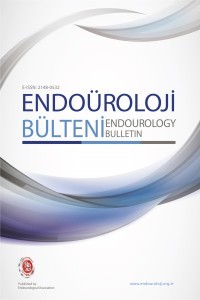Kodlama sisteminin kullanışlılığı, ürogenital hastalık yüzdeleri ve ilgili kodların kullanım oranları
ICD-10 kod, ürogenital sistem hastalıkları, WHO, epidemioloji
Usability of icd-10 coding system, urogenital disease percentages and use rates for related codes
ICD-10 code, urogenital system diseases, WHO, epidemiology,
___
- 1. Hirsch JA, Nicola G, McGinty G, Liu RW, Barr RM, Chittle MD, Manchikanti L. ICD-10: History and Context. AJNR Am J Neuroradiol. 2016 Apr;37(4):596-9. doi: 10.3174/ajnr.A4696. Epub 2016 Jan 28.
- 2. World Health Organization: History of the Development of the ICD. http://www.who.int/classifications/icd/en/HistoryOfICD.pdf. Accessed November 4, 2015.
- 3. Gersenovic M. The ICD family of classifications. Methods Inf Med. 1995;34:172–175.
- 4. Jetté N, Quan H, Hemmelgarn B, Drosler S, Maass C, Moskal L, Paoin W, Sundararajan V, Gao S, Jakob R, Ustün B, Ghali WA; IMECCHI Investigators. The development, evolution, and modifications of ICD-10: challenges to the international comparability of morbidity data. Med Care. 2010 Dec;48(12):1105-10. doi: 10.1097/MLR.0b013e3181ef9d3e.
- 5. Khandwala YS, Zhang CA, Li S, Cullen MR, Eisenberg ML. Validity of Claims Data for the Identification of Male Infertility. Curr Urol Rep. 2017 Sep;18(9):68. doi: 10.1007/s11934-017-0714-7.
- 6. Jetté N, Reid AY, Quan H, Hill MD, Wiebe S. How accurate is ICD coding for epilepsy? Epilepsia. 2010 Jan;51(1):62-9. doi: 10.1111/j.1528-1167.2009.02201.x. Epub 2009 Jul 20.
- 7. Tollefson MK, Gettman MT, Karnes RJ, Frank I. Administrative data sets are inaccurate for assessing functional outcomes after radical prostatectomy. J Urol. 2011 May;185(5):1686-90. doi: 10.1016/j.juro.2010.12.039. Epub 2011 Mar 21.
- Yayın Aralığı: 3
- Başlangıç: 2020
- Yayıncı: Pera Yayıncılık
Burak KÖPRÜ, Turgay EBİLOĞLU, Sinan AKAY, Selçuk SARIKAYA, Murat ZOR, Engin KAYA, Giray ERGİN, İbrahim YAVAN, Mesut GÜRDAL
RIRS’ta tam taşsızlık için prediktif faktörler; güncel bir retrospektif analiz
Gökhan ECER, Mehmet Giray SÖNMEZ, Mehmet BALASAR, Arif AYDIN, Ahmet ÖZTÜRK
Huseyin KOCAN, Ilker YİLDİRİM, Sinharib CİTGEZ, Mahmut TOKTAS, Selahattin ÇALIŞKAN, Enver ÖZDEMİR
Medikal tedaviye dirençli aşırı aktif mesane tedavisinde detrüsör içi botulinum toksin enjeksiyonu
Adem Emrah COĞUPLUGİL, Bahadır TOPUZ, Sercan YİLMAZ, Murat ZOR, Mesut GÜRDAL
Sercan YİLMAZ, Bahadır TOPUZ, Can SİCİMLİ, Adem Emrah COĞUPLUGİL, Engin KAYA, Murat ZOR, Selahattin BEDİR
Erhan DEMİRELLİ, Ercan ÖĞREDEN, Mefail AKSU, Mehmet KARADAYI, Ural OĞUZ
